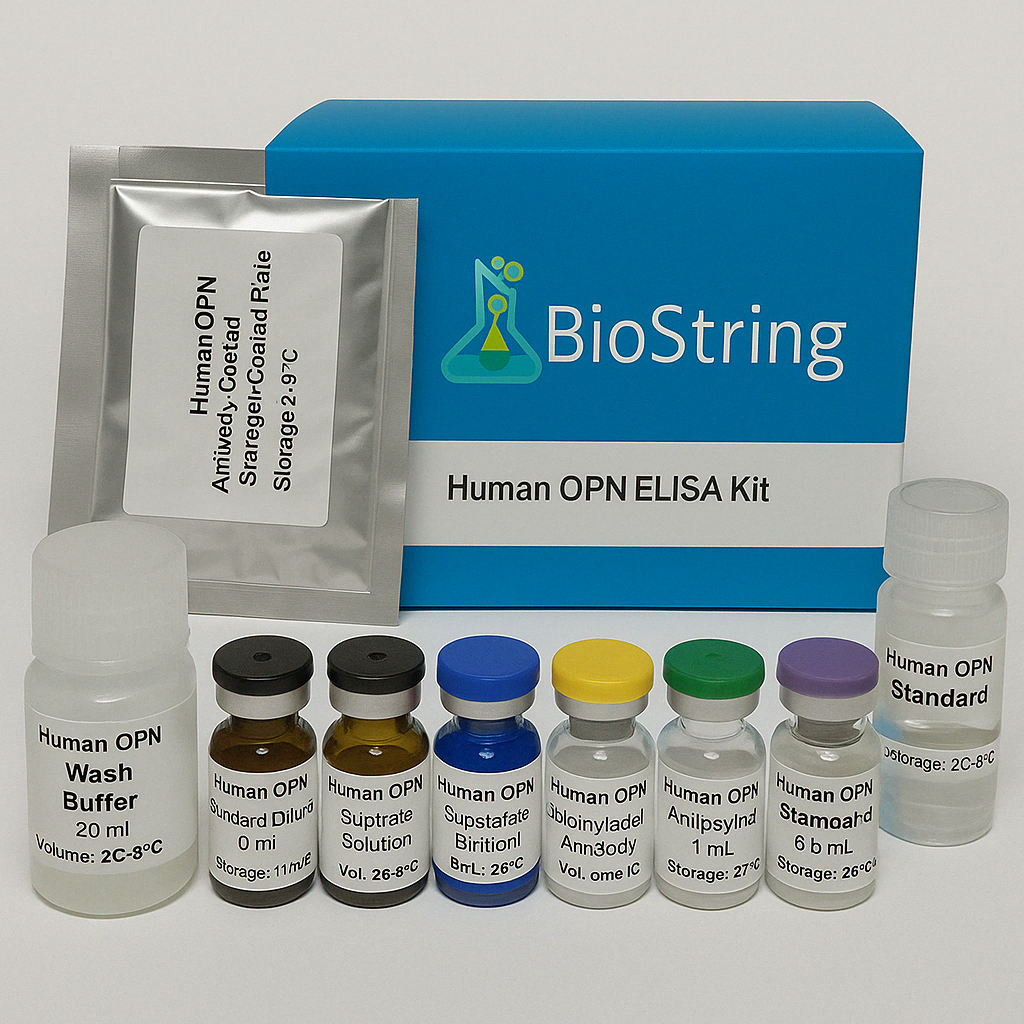Principle
The kit assay Feline IgE level in the sample use Purified Feline IgE antibody to coat microtiter plate wells, make solid-phase antibody, then add IgE to wells, Combined IgE antibody which With HRP labeled, become antibody – antigen – enzyme-antibody complex, after washing Completely, Add TMB substrate solution substrate becomes blue color At HRP enzyme-catalyzed, reaction is terminated by the addition of a Sulphuric acid solution and the color change is measured spectrophotometrically at a wavelength of 450 nm. The concentration of IgE in the samples is then determined by comparing the O.D. of the samples to the standard curve.
Materials Provided with the Kit
| Materials provided with the kit | 96 - Determinations | Storage |
| User Manual | 1 | - |
| Closure Plate Membrane | 2 | - |
| Sealed Bags | 1 | - |
| Micro Elisa Strip Plate | 1 | 2-8℃ |
| Standard:7.2 ng/ml | 0.5ml×1 bottle | 2-8℃ |
| Standard Diluent | 1.5ml×1 bottle | 2-8℃ |
| HRP-Conjugate Reagent | 6ml×1 bottle | 2-8℃ |
| Sample Diluent | 6ml×1 bottle | 2-8℃ |
| Chromogen Solution A | 6ml×1 bottle | 2-8℃ |
| Chromogen Solution B | 6ml×1 bottle | 2-8℃ |
| Stop Solution | 6ml×1 bottle | 2-8℃ |
| Wash Solution | (20ml×30 fold)×1bottle | 2-8℃ |
Specimen Requirements
- serum- coagulation at room temperature 10-20 mins centrifugation 20-min at the speed of 2000-3000 r.p.m. remove supernatant, If precipitation appeared, Centrifugal again.
- plasma-use suited EDTA or citrate plasma as an anticoagulant, mix 10-2 mins ,centrifugation 20-min at the speed of 2000-3000 r.p.m. remove supernatant, If precipitation appeared, Centrifugal again
- Urine-collect sue a sterile container, centrifugation 20-min at the speed of 2000-3000 r.p.m. remove supernatant, If precipitation appeared, Centrifugal again. The Operation of Hydrothorax and cerebrospinal fluid Reference to it.
- cell culture supernatant-detect secretory components, collect sue a sterile container, centrifugation 20-min at the speed of 2000-3000 r.p.m. remove supernatant, detect the composition of cells, Dilute cell suspension with PBS(PH7.2-7.4), Cell concentration reached 1 million / ml, repeated freeze-thaw cycles, damage cells and release of intracellular components, centrifugation 20-min at the speed of 2000-3000 r.p.m. remove
supernatant, If precipitation appeared, Centrifugal again - Tissue samples- After cutting samples, check the weight, add PBS(PH7.2-7.4), Rapidly frozen with liquid nitrogen, maintain samples at 2-8℃ after melting, add PBS(PH7.4, Homogenized by hand or Grinders, centrifugation 20-min at the speed of 2000-3000 r.p.m. remove supernatant.
- extract as soon as possible after Specimen collection, and according to the relevant literature, and should be experiment as soon as possible after the extraction. If it can’t, specimen can be kept in -20 ℃ to preserve, Avoid repeated freeze-thaw cycles.
- Can’t detect the sample which contain NaN3, because NaN3 inhibits HRP active.
Assay Procedure
Dilute and add sample to Standard: Set 10 Standard wells on the ELISA plates coated, add Standard 100μl to the first and the second well, then add Standard dilution 50μl to the first and the second well, mix; take out 100μl form the first and the second well then add it to the third and the forth well separately. then add Standard dilution 50μl to the third and the forth well ,mix ; then take out 50μl from the third and the forth well discard, add 50μl to the fifth and the sixth well ,then add Standard dilution 50μl to the fifth and the sixth well, mix ; take out 50μl from the fifth and the sixth well and add to the seventh and the eighth well, then add Standard dilution 50μl to the seventh and the eighth well ,mix ; take out 50μl from the seventh and the eighth well and add to the ninth and the tenth well, add Standard dilution 50μl to the ninth and the tenth well, mix , take out 50μl from the ninth and the tenth well discard(add Sample 50μl to each well after Diluting ,(density:4.8 ng/ml,3.2 ng/ml,1.6 ng/ml,0.8 ng/ml, 0.4 ng/ml)
add sample Set: blank wells separately (blank comparison wells don’t add sample and HRP-Conjugate reagent, other each step operation is same). testing sample well. add Sample dilution 40μl to testing sample well, then add testing sample 10μl (sample final dilution is 5-fold), add sample to wells , don’t touch the well wall as far as possible Gently mix.
Incubate: After closing plate with Closure plate membrane ,incubate for 30 min at 37℃.
Configurate liquid: wash solution diluted 30-fold with distilled water and reserve.
washing: Uncover Closure plate membrane, discard Liquid, dry by swing, add washing buffer to every well, still for 30s then drain, repeat 5 times, dry by pat.
add enzyme: Add HRP-Conjugate reagent 50μl to each well, except blank well.
incubate: Operation with 3.
washing: Operation with 5.
color: Add Chromogen Solution A 50ul and Chromogen Solution B to each well, evade the light preservation for 15 min at 37℃.
Stop the reaction: Add Stop Solution50μl to each well, Stop the reaction(the blue color change to yellow color).
assay: take blank well as zero , Read absorbance at 450nm after Adding Stop Solution and within 15 min.
Important Notes
- The kit takes out from the refrigeration environment should be balanced 15-30 minutes in the room temperature, ELISA plates coated if has not use up after opened, the plate should be stored in Sealed bag.
- washing buffer will Crystallization separation, it can be heated the water helps dissolve when dilute . Washing does not affect the result.
- add Sample with sampler Each step, And proofread its accuracy frequently, avoids the experimental error. add sample within 5 mins, if the number of sample is much , recommend to use Volley .
- if the testing material content is excessively higher (The sample OD is bigger than the first standard well ),please dilute Sample (n-fold), Please diluente and multiplied by the dilution factor.(×n×5).
- Closure plate membrane only limits the disposable use, to avoid cross-contamination.
- The substrate evade the light preservation.
- Please according to use instruction strictly, The test result determination must take the microtiter plate reader as a standard.
- All samples, washing buffer and each kind of reject should according to infective material process.
- Don’t mix reagents with those from other lots
Calculate
Take the standard density as the horizontal, the OD value for the vertical ,draw the standard curve on graph paper, Find out the corresponding density according to the sample OD value by the Sample curve, multiplied by the dilution multiple, or calculate the straight line regression equation of the standard curve with the standard density and the OD value ,with the sample OD value in the equation, calculate the sample density, multiplied by the dilution factor, the result is the sample actual density.
Precision
Intra-assay Precision (Precision within an assay): 3 samples with low, middle and high level Feline IgE were tested 20 times on one plate, respectively. Inter-assay Precision (Precision between assays): 3 samples with low, middle and high level Feline IgE were tested on 3 different plates, 8 replicates in each plate.
CV(%) = SD/meanX100
Intra-Assay: CV<10%
Inter-Assay: CV<12%
Assay range: 0.1 ng/ml -5 ng/ml
Sensitivity: 0.01 ng/ml
Storage: 2-8℃.
validity: Six months



Reviews
There are no reviews yet.